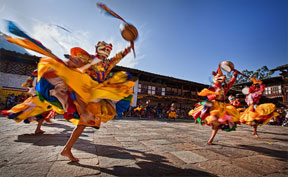Related Bhutan Topics
✓ About Bhutan
✓ Country Facts
✓ Gross National Happiness
✓ Art & Architecture
✓ Climatic Conditions
✓ People & Culture
✓ History
Festivals of Bhutan
Tshechus are grand events where entire communities come together to witness religious mask dances, receive blessings and socialize. In addition to the mask dances tshechus also include colorful Bhutanese dances and other forms of entertainment. Read more >>

Bhutan is a small landlocked country in the Eastern Himalayas bordered by China in the North and India on the other three sides. It has a total land area of 38,394 sq. km. and measures approximately 150 km north to south and 300 km east to west. The landscape is characterized by rugged terrain and steep mountain valleys ranging from 150 meters in the subtropical valleys in the southern foothills, through temperate zone to heights exceeding 7,000 meters in the alpine regions of the mountains.
Bhutan has over 72% of its land under forest cover maintaining its rich biodiversity. The national parks and the wildlife sanctuaries are home to some of the rarest and most significant animals in the world. Bhutan has one of the richest biodiversities in the world with about 3,281 plant species per 10,000 square kilometers and has been declared as one of the ten global biodiversity ‘hot spots’.
The country’s forests of temperate and sub-tropical species are home to many rare species of flora and fauna. An estimated 770 species of birds and over 50 species of rhododendron, along with an astonishing variety of medicinal plants (over 300 species) and orchids are endemic to this region.
Rare animals like the golden langur, takin, and snow leopard are found distributed widely in Bhutan. Bhutan is also one of the wintering grounds for the rare and endangered black-necked cranes. Bhutan is endowed with a river system that has an estimated potential to generate 30,000 MW of hydroelectricity.
The steep and unstable terrain and the relatively young mountain system, however, render the country to be ecologically very fragile. Agricultural production is also severely constrained, as only around 8% of the land area is cultivable.
Bhutan has three distinct climatic zones corresponding broadly to the three geographical divisions – hot and humid southern belt, cool temperate central zone, and alpine northern region.




